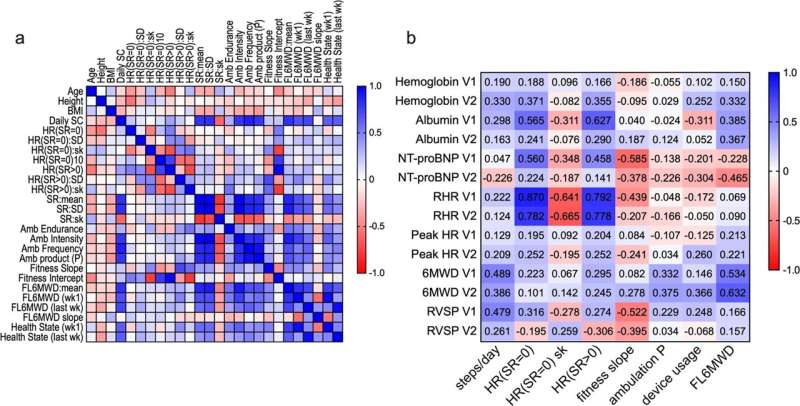Wearable activity trackers can be used to determine health metrics that could support clinical care

A new Johns Hopkins study shows that data gathered from wearable activity trackers can be used to obtain several metrics associated with the user's general physical health and cardiovascular health status. While these sensors are generally marketed as daily step counters, the Johns Hopkins research team believes they could potentially serve a greater purpose: supporting clinical care for patients with pulmonary arterial hypertension (PAH) and other chronic diseases.
The study was published in npj Digital Medicine on Nov. 9.
"The purpose of this study was to show that clinically relevant metrics beyond daily step count can be derived from these wearable activity monitors," says Zheng "Peter" Xu, Ph.D., the study's first author and a postdoctoral fellow for inHealth, a strategic initiative to advance precision medicine at The Johns Hopkins University.
"Historically, remote monitoring of a patient's physical status has been challenging. We wanted to meet that challenge and see what kind of untapped information is contained within these devices that could help us support patients with PAH."
The Cleveland Clinic provided the Johns Hopkins research team with activity tracker-obtained data for 22 individuals with PAH who wore activity trackers between two clinic visits. At both clinic visits, Cleveland Clinic medical professionals recorded 26 health measurements of each participant, including health-related quality of life, heart rate measurements and results from the commonly used aerobic capacity and endurance test known as the six-minute walk distance (6MWD) test.
Using the minute-to-minute step rate and heart rate data of each participant, the Johns Hopkins team ascertained several metrics broadly associated with physical health and cardiovascular function. These included the distribution of heart rate and intensity and frequency of walking instances throughout each week, as well as results from an analog version of the 6MWD test that the team dubbed the free-living six-minute walk distance test.
These data enabled the team to understand each participant's health status and to identify subgroups among participants with similar metrics to one another.
To demonstrate that these data have potential for clinical use, the team also compared the activity-tracker metrics with the 26 health metrics recorded during both clinic visits—and found some unexpected correlations. For example, an activity tracker-measured fitness assessment (based on step count and heart rate data) correlated with levels of clinically measured NT-proBNP, a blood biomarker used to assess risk of heart failure. Across the 22 participants, the research team found statistically significant differences in 18 of these metrics.
"Finding so many statistically significant differences in a relatively small cohort suggests to us that activity-tracker data may make it possible to identify surrogate markers of disease severity that can be monitored remotely," says Peter Searson, Ph.D., senior author of the study and the Joseph R. and Lynn C. Reynolds Professor at the Johns Hopkins University Whiting School of Engineering. "These data could potentially contribute to the identification of patients who would benefit from more frequent clinic visits or specific medications."
"We also believe that activity tracker-measured health parameters could serve as proxies for clinically measured health parameters of patients with chronic disease," adds Searson.
Next, the research team is exploring whether these devices could support clinical care for patients with chronic obstructive pulmonary disease (COPD) and scleroderma. Collaborating with the Johns Hopkins COPD Precision Medicine Center of Excellence, they will seek to determine whether signals derived from activity trackers can be used to predict the risk of a COPD flareup.
More information: Zheng Xu et al, Evaluation of physical health status beyond daily step count using a wearable activity sensor, npj Digital Medicine (2022). DOI: 10.1038/s41746-022-00696-5




















